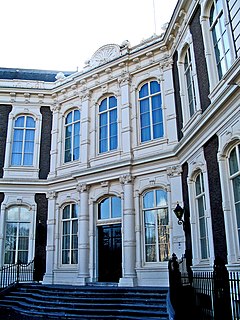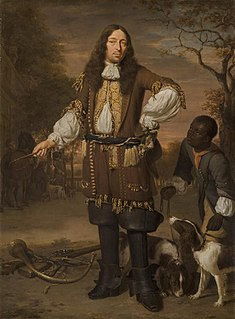
The Dutch Republic, or the United Provinces, was a confederal republic that existed from the formal creation of a confederacy in 1581 by several Dutch provinces—seceded from Spanish rule—until the Batavian Revolution in 1795. It was a predecessor state of the Netherlands and the first Dutch nation state.

In the Low Countries, stadtholder was an office of steward, designated a medieval official and then a national leader. The stadtholder was the replacement of the duke or earl of a province during the Burgundian and Habsburg period (1384–1581/1795).

William II was sovereign Prince of Orange and stadtholder of the United Provinces of the Netherlands from 14 March 1647 until his death three years later. His only child, William III, reigned as King of England, Ireland, and Scotland.

William IV was Prince of Orange-Nassau and the first hereditary stadtholder of all the United Provinces.

The Council of State is a constitutionally established advisory body in the Netherlands to the government and States General that officially consists of members of the royal family and Crown-appointed members generally having political, commercial, diplomatic or military experience. It was founded in 1531, making it one of the world's oldest still-functioning state organisations.
A pensionary was a name given to the leading functionary and legal adviser of the principal town corporations in the Low Countries because they received a salary, or pension.
The grand pensionary was the most important Dutch official during the time of the United Provinces. In theory he was only a civil servant of the Estates of the dominant province among the Seven United Provinces: the county of Holland. In practice the grand pensionary of Holland was the political leader of the entire Dutch Republic when there was no stadtholder at the centre of power.
The States General of the Batavian Republic was the name for the Dutch government between January, 1795 and March 1796. It was nominally the same as the States-General of the Dutch Republic, the predecessor of the Batavian Republic, as the old constitution, the Union of Utrecht remained in place till a new National Assembly of the Batavian Republic was seated after a general election, under universal manhood suffrage. As under the old constitution the States of the seven provinces remained the basis for representation in the States-General. However, those States were in most cases replaced by new representative bodies, like the Provisional Representatives of the People of Holland.The places of the members of the previous Orangist regime as representatives of the Seven Provinces were now taken by members of the Patriot party. The presidents of the States-General, both under the old and the new Republic, were acting as head of state for their term in office as president.

In the 16th, 17th and 18th centuries, the regenten were the rulers of the Dutch Republic, the leaders of the Dutch cities or the heads of organisations. Though not formally a hereditary "class", they were de facto "patricians", comparable to that ancient Roman class. Since the late Middle Ages Dutch cities had been run by the richer merchant families, who gradually formed a closed group. At first the lower-class citizens in the guilds and schutterijen could unite to form a certain counterbalance to the regenten, but in the course of the 15th century the administration of the cities and towns became oligarchical in character. From the latter part of the 17th century the regent families were able to reserve government offices to themselves via quasi-formal contractual arrangements. In practice they could only be dislodged by political upheavals, like the Orangist revolution of 1747 and the Patriot revolt of 1785.

Cornelis de Graeff, also Cornelis de Graeff van (Zuid-)Polsbroek was the most illustrious member of the De Graeff family. He was a mayor of Amsterdam from the Dutch Golden Age and a powerful Amsterdam regent after the sudden death of stadholder William II of Orange. Like his father Jacob Dircksz de Graeff, he opposed the house of Orange, and was the moderate successor to the republican Andries Bicker. In the mid 17th century he controlled the city's finances and politics and, in close cooperation with his brother Andries de Graeff and their nephew Johan de Witt, the Netherlands political system.

The Second Stadtholderless Period or Era is the designation in Dutch historiography of the period between the death of stadtholder William III on March 19, 1702 and the appointment of William IV as stadtholder and captain general in all provinces of the Dutch Republic on May 2, 1747. During this period the office of stadtholder was left vacant in the provinces of Holland, Zeeland, and Utrecht, though in other provinces that office was filled by members of the House of Nassau-Dietz during various periods. During the period the Republic lost its Great-Power status and its primacy in world trade, processes that went hand-in-hand, the latter causing the former. Though the economy declined considerably, causing deindustralization and deurbanization in the maritime provinces, a rentier-class kept accumulating a large capital fund that formed the basis for the leading position the Republic achieved in the international capital market. A military crisis at the end of the period caused the fall of the States-Party regime and the restoration of the Stadtholderate in all provinces. However, though the new stadtholder acquired near-dictatorial powers, this did not improve the situation.

Jonkheer Douwe Sirtema van Grovestins was a Frisian courtier at the court of stadtholder William IV, Prince of Orange, and later at the court of his widow Anne, Princess Royal and Princess of Orange. He was first Chamberlain, later Equerry to the stadtholder, and equerry to the Princess after her husband's death.

Jan Gerritsz. Bicker (1591–1653) was a merchant, a mayor (burgomaster) and a member of the Bicker family, an influential patrician family from Amsterdam.

Johan de la Faille was a member of the vroedschap in Delft. As a supporter of prince William III of Orange, he was appointed in 1672, the Year of Disaster after the First Stadtholderless Period, when the Dutch Republic was in danger.
Daniël Raap was a porcelain merchant who played a leading role during the Orangist revolution in the Netherlands of 1747–1751.

Willem, Count Bentinck, Lord of Rhoon and Pendrecht was a Dutch nobleman and politician, and the eldest son from the second marriage of William Bentinck, 1st Earl of Portland. He was created Count (Graf) Bentinck of the Holy Roman Empire in 1732. Bentinck played a leading role in the Orangist revolution of 1747 in the Netherlands.
Second period may refer to:
The Dutch States Party is the name used in Anglophone historiography for the faction in the politics of the Dutch Republic referred to in (older) Dutch historiography as the Staatsgezinde partij. This republican faction is usually (negatively) defined as the opponents of the Orangist, or Prinsgezinde faction, who supported the monarchical aspirations of the stadtholders, who were usually members of the House of Orange-Nassau. The two factions existed during the entire history of the Republic since the Twelve Years' Truce, be it that the role of "usual opposition party" of the States party was taken over by the Patriots after the Orangist revolution of 1747. The States party was in the ascendancy during the First Stadtholderless Period and the Second Stadtholderless Period.

The Statenvlag is the name of the flag of the States-General of the Dutch Republic, the red-white-blue tricolour flag replacing the older orange-white-blue Prince's Flag in the mid 17th century. The modern national flag of the Netherlands, officially introduced in 1937, is based on this historical flag.











